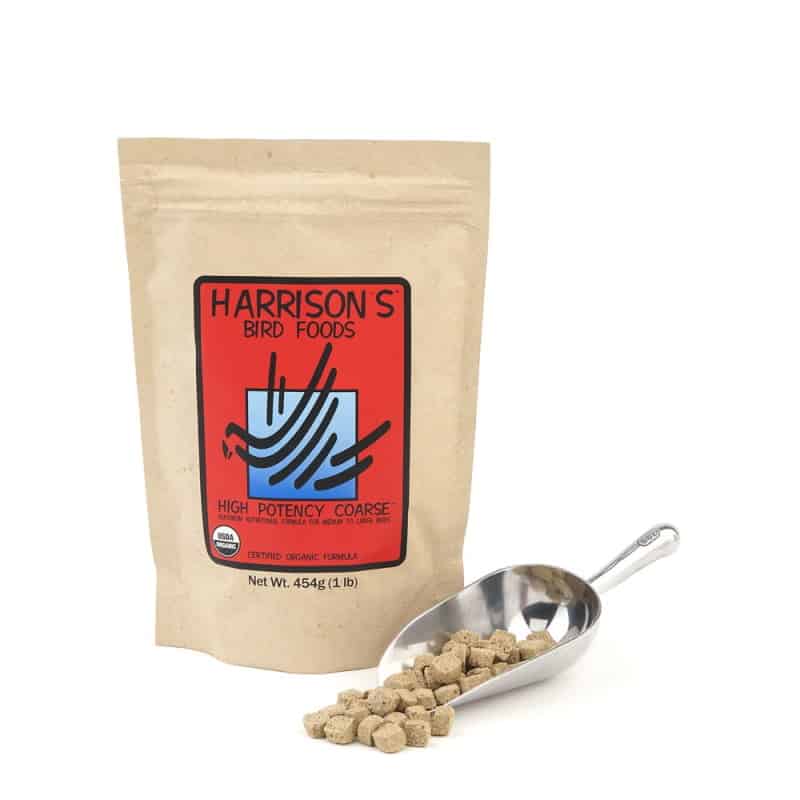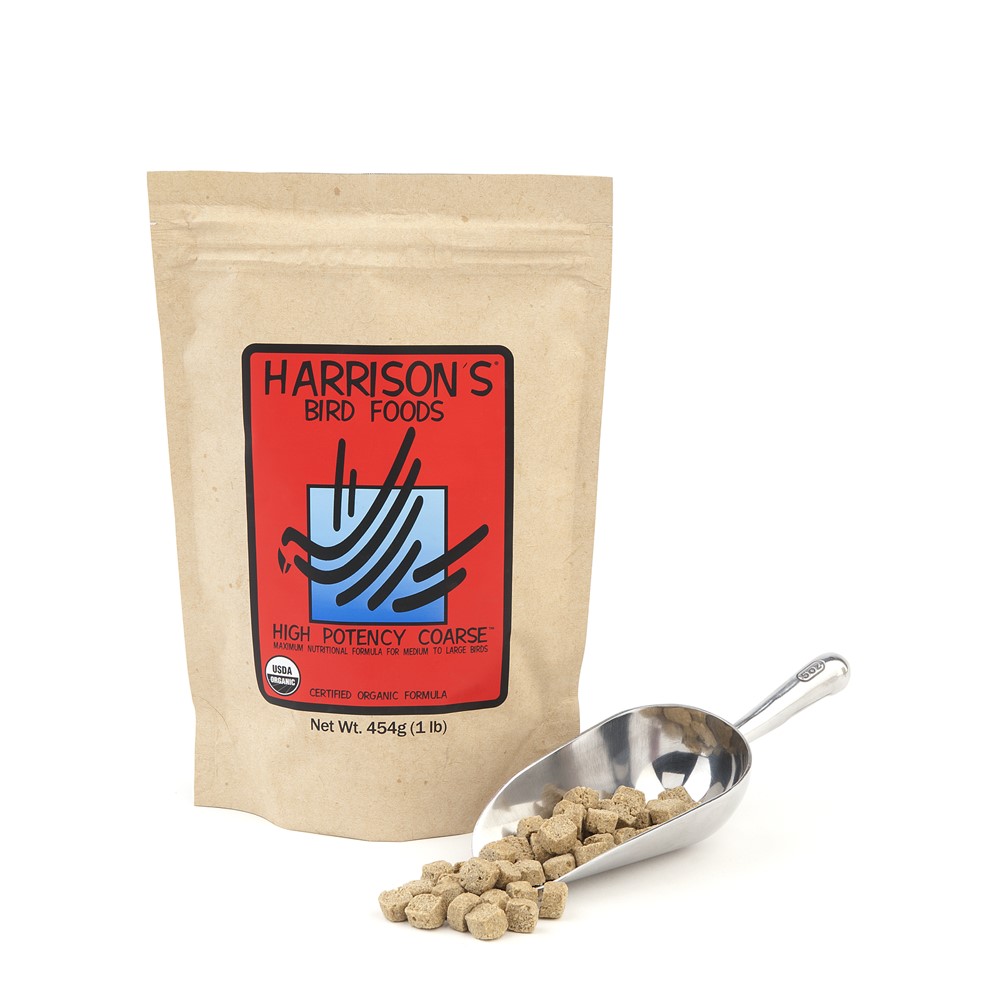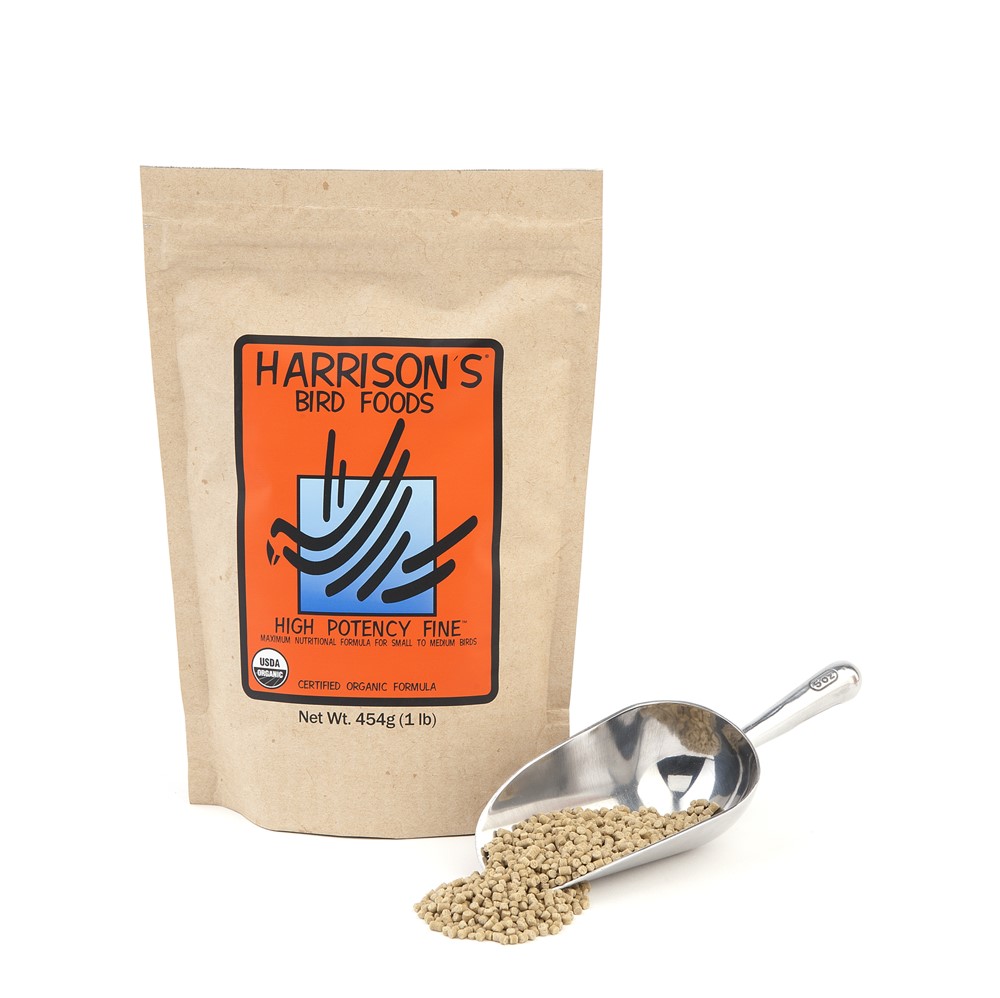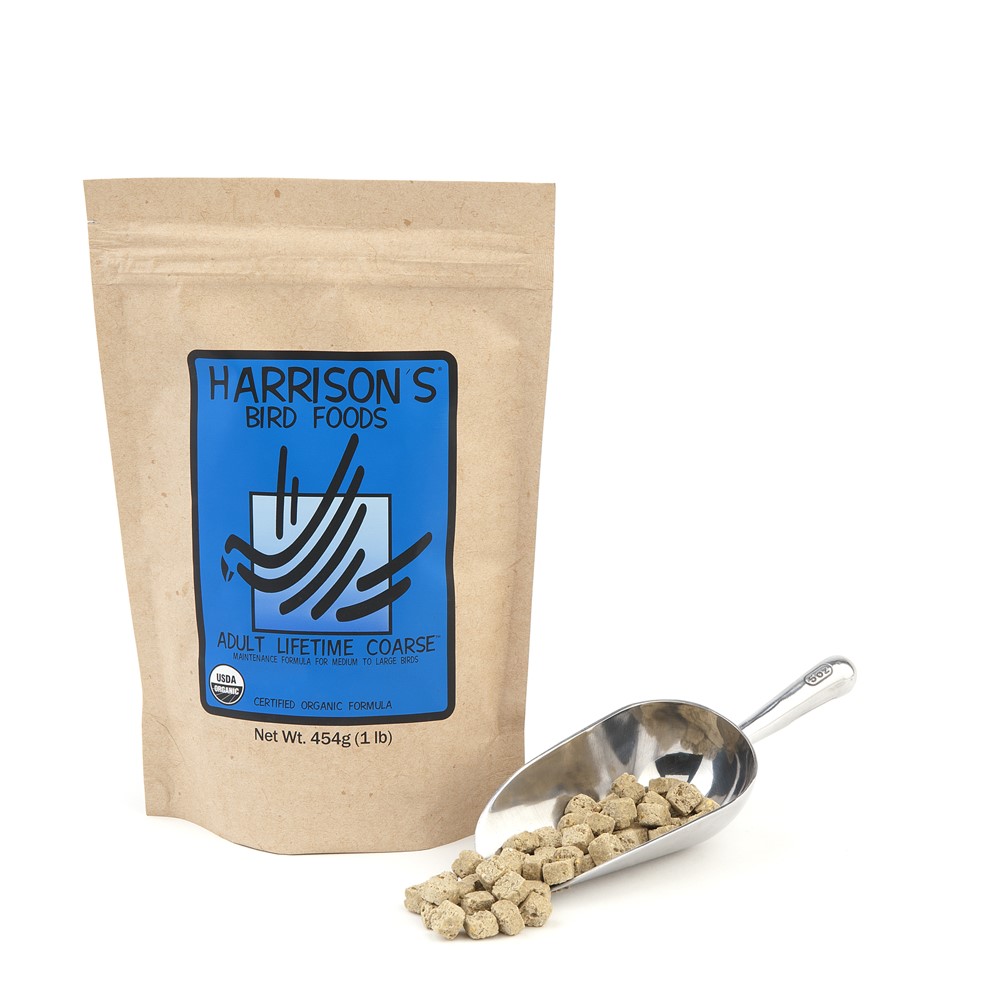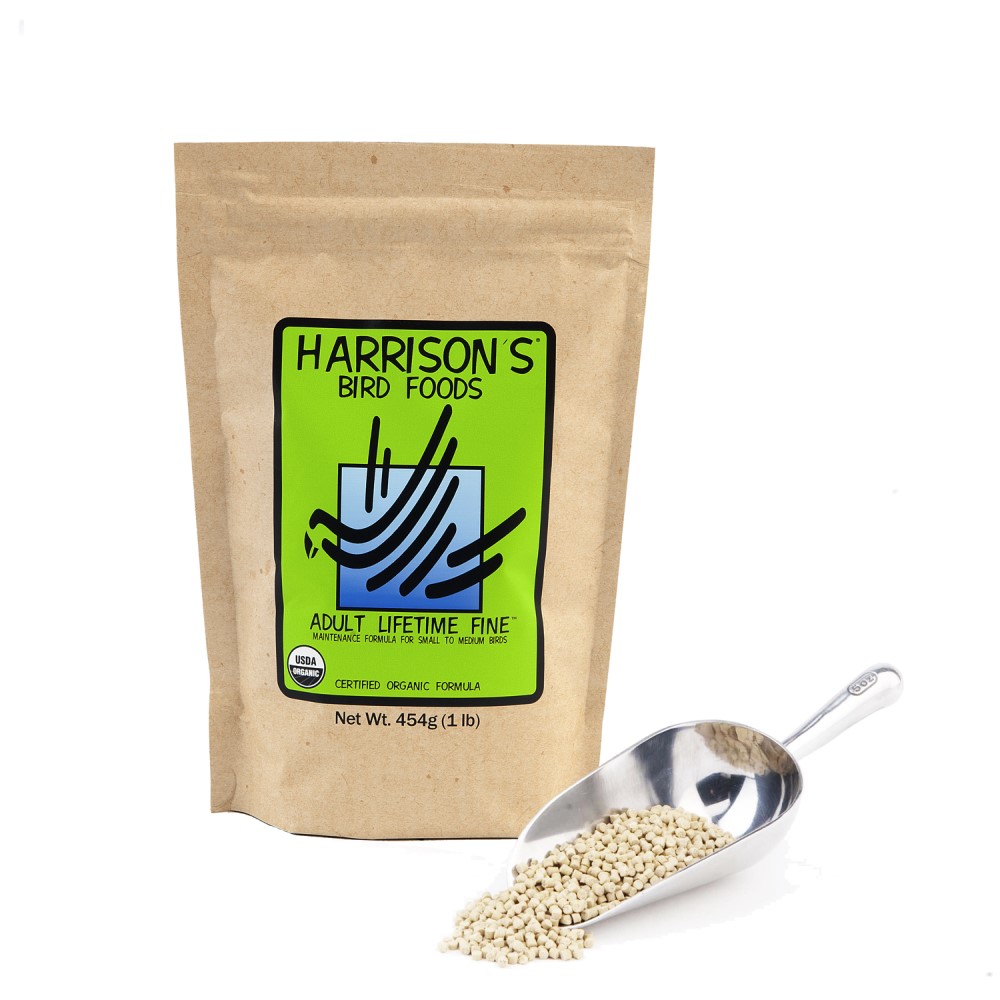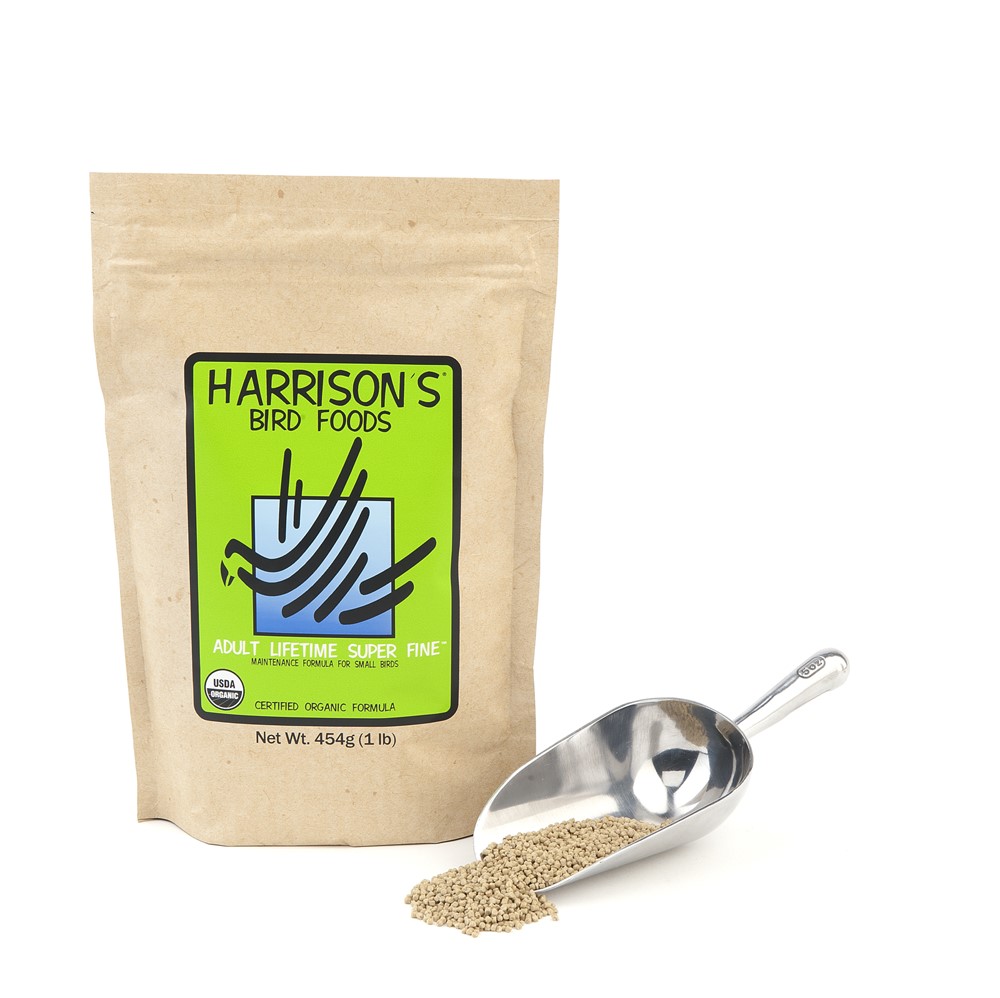Informative
Harrison’s Bird Foods
The following advice are taken from the official Harrison’s Bird Foods website.
WHICH FOOD TO CHOOSE
All Harrison’s Bird Foods are formulated to provide pet birds with the nutrition needed for good health. The necessary levels of energy, protein, vitamins and minerals are all provided and there is no need for the use of additional supplements.
There are two main types of diet: High Potency and Adult Lifetime. The formulations differ slightly in nutritional content – mainly the fat and protein levels (influencing the calorific value) – making them appropriate for use in a variety of different nutritional and clinical situations. These are outlined below.
Thereafter, the principal difference between the Harrison’s foods is the size of the nugget. Which size you choose is down to the preference of your bird and how they usually eat their food. The foods most commonly fed to each type of bird are shown below, but this is just a guide – if a bird prefers a different size of piece to ‘the norm’ then feed them this as they will still receive the same balanced nutritional benefit.
The Harrison’s range also includes treats and hand-feeding foods for all pet birds.
HIGH POTENCY DIETS
High Potency diets provide the correct balance of essential vitamins and minerals and have a slightly higher calorific value, making them more suitable for birds which:
- are converting from a seed based diet
- have higher metabolic rates and benefit from higher energy diets, e.g. African Grey, large macaws, or palm/moluccan cockatoos
- are still young and developing
- are moulting or have poor feathers
- are recovering from illness
- you wish to bring into breeding condition or are feeding young
ADULT LIFETIME DIETS
Adult Lifetime diets provide the correct balance of essential vitamins and minerals and have a slightly lower calorific value, making them more suitable for birds which:
- have been eating High Potency for 6 months since conversion as this is a more appropriate long-term diet (excluding species benefitting from High Potency – see above)
- may be diabetic
- need help preventing chronic egg laying (typically cockatiels), or which are showing signs of undesired breeding behaviour
- have problems controlling their weight (e.g. Amazons, galahs).
SIZE OF PIECE
You should feed whichever size of piece you think your bird will prefer, however most birds of the same size will eat in the same way, so in most instances the following information will be helpful…
COARSE
- Larger pieces that bigger parrots can pick up and eat from their feet.
- e.g. Cockatoos, African Greys, Macaws, Amazons, Eclectus, Pionus…
FINE
- Smaller pieces for smaller parrots who pick them up in their beak directly from the bowl.
- e.g. Senegals, Quakers, Parakeets, Cockatiels, Conures, Lories…
SUPERFINE
- The smallest pieces, for small birds which peck directly from the bowl.
- e.g. Canaries, Budgies, Finches, Doves…
MASH
- A ‘coarse’ powder. Suitable for all birds, it can be moistened, or sprinkled onto fruit or vegetables, or served dry to birds which peck directly from the bowl.
FEEDING ADDITIONAL ITEMS
Whilst Harrison’s is scientifically formulated to be a nutritionally balanced diet it is recommended that owners also feed a limited amount of fruit and vegetables to their pet birds, however these additional food items should be limited to no more than 10% by volume of the overall diet. Controlling the intake is to ensure that your pet gets the majority of its food in a form which is balanced for energy, protein and essential minerals and vitamins.
Over-feeding of additional (energy rich but often micronutrient poor) items may result in a dilution and imbalance of these nutrients in the overall diet. It is important to carefully follow supplementation guidelines for Harrison’s to be fully effective.
Because Harrison’s Diets are scientifically formulated it is not required nor recommended to supplement with vitamins, minerals or other bird or animal food products unless explicitly directed by your avian veterinarian.
When feeding fruit and vegetable where possible it is best to offer certified organic vegetables and fruits in small quantities; select dark yellow meaty or dark green leafy items such as sweet potatoes, carrots, pumpkin, winter squash, broccoli, parsley, spinach, mango or papaya. Try and avoid those high in sugars (such as grapes) as they provide energy but little else.
FOR BIRDS WITH SUSPECTED IRON-STORAGE DISEASE
There are many suggestions as to the contributory factors predisposing to Iron Storage Disease (ISD) in captive birds. Some species are known to be particularly affected but the condition has been recorded in a wide range of species including parrots. For those pet birds where ISD has been diagnosed or suspected there are some dietary considerations that should be followed.
Avoid grapes, currants, raisins, liver, red meat, egg yolk or dark green vegetables such as spinach, which may contain high levels of iron. Avoid citrus fruits, tomatoes, kiwi, strawberries and other foods containing vitamin C as this increases the absorption of iron from the diet.
The organic nature of the products used to manufacture Harrison’s means that there is natural variability in the levels of iron in the foods and whilst Harrison’s diets, are not designated ‘low iron’ diets (recommended at >70ppm) they are low in iron.
CONVERSION ADVICE
Hopefully your birds will eat Harrison’s Bird Foods as soon as you offer it to them. Many owners find that their birds enjoy the food immediately and they can switch them to a Harrison’s diet straight away.
To increase the likelihood of this happening, feed the Harrison’s in their usual feeding bowl in place of their regular seed/pellets. If you feed both at the same time they will likely just eat the food they know. If you just feed Harrison’s they are likely to try it.
If your bird is then reluctant to try the food there are some suggestions below on how to introduce the food to them.
If the conversion steps don’t work the first time (we would recommend a concerted effort for a minimum of 2 weeks*), you can feed your bird’s familiar food for a short time and then try again. The effort is worthwhile for the health of your bird.
*Note: The bird’s weight, body condition, attitude and droppings should be monitored carefully during the conversion process. It is important to ensure the bird is eating sufficient food and so regular weight checks (on a daily basis in small and medium birds and at least twice a week in large birds) should be carried out to ensure there is no undue weight loss. Always consult your veterinarian if you have any concerns.
DISCOURAGE SELECTIVE FEEDING
For about 7-10 days prior to conversion to Harrison’s, limit the volume of ‘regular’ food that is provided at any one time to approximately one third of the usual daily serving. Food is only replenished when all has been eaten. This prevents the bird from buffet feeding and encourages it to eat the food that is available. Also if the ‘regular’ food is a mix containing a high percentage of sunflower seeds then it is helpful to remove the majority of these prior to conversion to Harrison’s.
WEANING THE BIRD OFF ITS OLD DIET
Offer a small amount of their usual food in the morning and evening for 1 hour and then remove this from the bowl. Replace with Harrison’s High Potency, serving in their usual bowl, in the usual place in the cage – this confirms that it is ‘food’, rather than a toy. Give less than will cover the bottom of their bowl – to discourage them for foraging for their ‘usual food’ – and make this the only food that is available to them during the main part of the day.
The next day, give your bird seeds for only 30 minutes in the morning and evening. The third day, reduce the time to 15 minutes twice a day. And finally, offer only High Potency on the fourth day. Monitor the bird’s droppings.
FEED YOUR BIRD AT MEALTIME
Place the food on a plate, move it around with your finger or a spoon and eat it (or pretend to eat it) in front of your bird. Whilst Harrison’s formulated diets can be a little bland for the human palate (humans have about 30 times more taste buds than parrots), they are palatable, organic and made from human quality food, and many birds are encouraged to try the food if they see their owners eating and ‘enjoying’ it. This is particularly sucessful if the birds are used to being fed at mealtimes.
WARM OR MOISTEN THE FOOD
Many birds can be encouraged to taste the food, and will readily consume it, if a small amount of water or fruit juice is added. Alternatively try slightly warming the High Potency formula.
CHANGE THE BIRD’S ENVIRONMENT
Whilst feeding the food in the ‘normal way’ is usually best, if this is not successful, and for small psittacine birds, moving the bird into a new home such as a light box, aquarium or even a new cage can work. Remove all the toys, perches and bowls and offer the formulated diet loose on the floor. In addition, sprinkling food on a mirror or sheet of white paper placed on the bottom of the cage can work especially well for budgies. A bird old enough to be socialised may eat the food in order to compete with the “rival” bird in the mirror and using white paper will draw attention to the food.
TRY HARRISON’S BIRD BREAD
Harrison’s Bird Bread Mix is an extremely effective conversion tool. Food that the bird currently eats may be added to the mix and baked in the bread. Gradually reduce the amount of that food and replace with the appropriate Harrison’s formula.
USE A CONVERTED BIRD AS A ROLE MODEL
If you already have a converted bird then house the new bird near the one that is already eating a formulated diet. If compatible, place the birds in the same cage and use the converted bird as a “trainer bird”.
OFFER POWER TREATS OR PEPPER LIFETIME COARSE
Many birds love the nuttier taste of Power Treats and the chilli flavour of Pepper Lifetime Coarse so it is a great way to help your bird try a new food. These foods can be crushed for smaller birds.
VETERINARY SUPERVISED CONVERSION
In some cases where birds do not convert readily, veterinary supervised conversion within the vet’s clinic may often succeed. Removing the bird from an emotional home environment and placing it in a clinic where regular monitoring can be undertaken will often help the conversion process.
BE CONFIDENT
Your bird will often pick up on your emotions so stay calm and confident and enjoy knowing that you are doing the best for your bird in helping your pet change to a better diet and a healthier way of life.

